Disposable Non-Enzymatic Glucose Sensors Using Screen-Printed Nickel/Carbon Composites on Indium Tin Oxide Electrodes
Abstract
:1. Introduction
2. Experimental Section
2.1. Chemicals and Reagents
2.2. Preparation of the DSPNCE
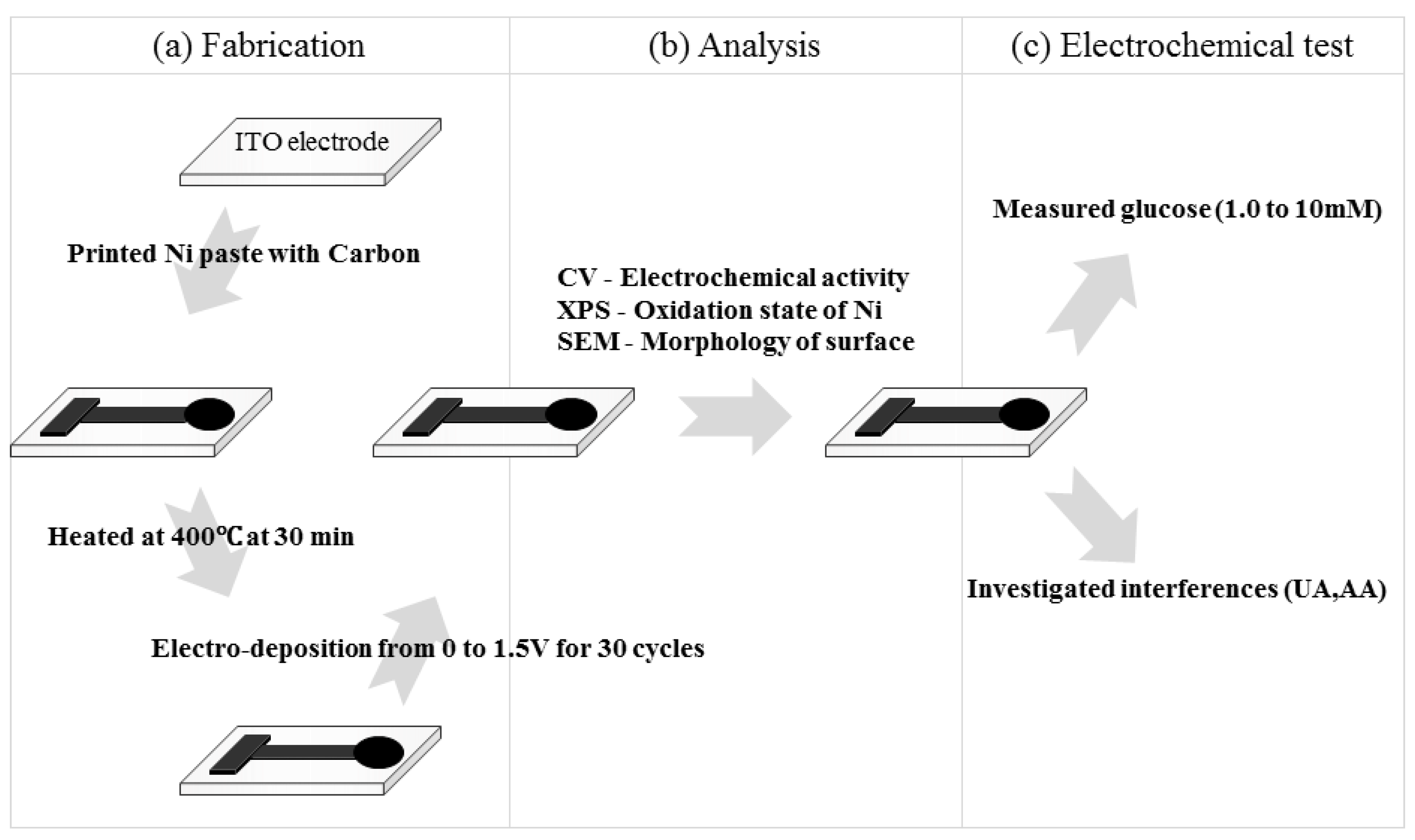
2.3. Spectroscopic Characterization of the DSPNCE Surface
2.4. Electrochemical Measurements
3. Results and Discussion
3.1. Characterization of the DSPNCE
3.1.1. Resistance for the DSPNCE Prepared under Various Fabrication Conditions
| Nickel (%) | Carbon (%) | Resistance (Ω) |
|---|---|---|
| 100 | 0 | N/A |
| 75 | 25 | 670 |
| 50 | 50 | 48 |
| 25 | 75 | 34 |
| 0 | 100 | 22 |
| Temperature (°C) | Resistance (Ω) | Note |
|---|---|---|
| Without Heating | 48 | |
| 100 | 34 | |
| 200 | 42 | |
| 300 | 78 | |
| 400 | 107 | |
| 500 | 128 | ITO was bent |
| 600 | 21000 | ITO was bent and carbon ink was detached |
3.1.2. Formation of Ni(OH)2/NiOOH on the DSPNCE
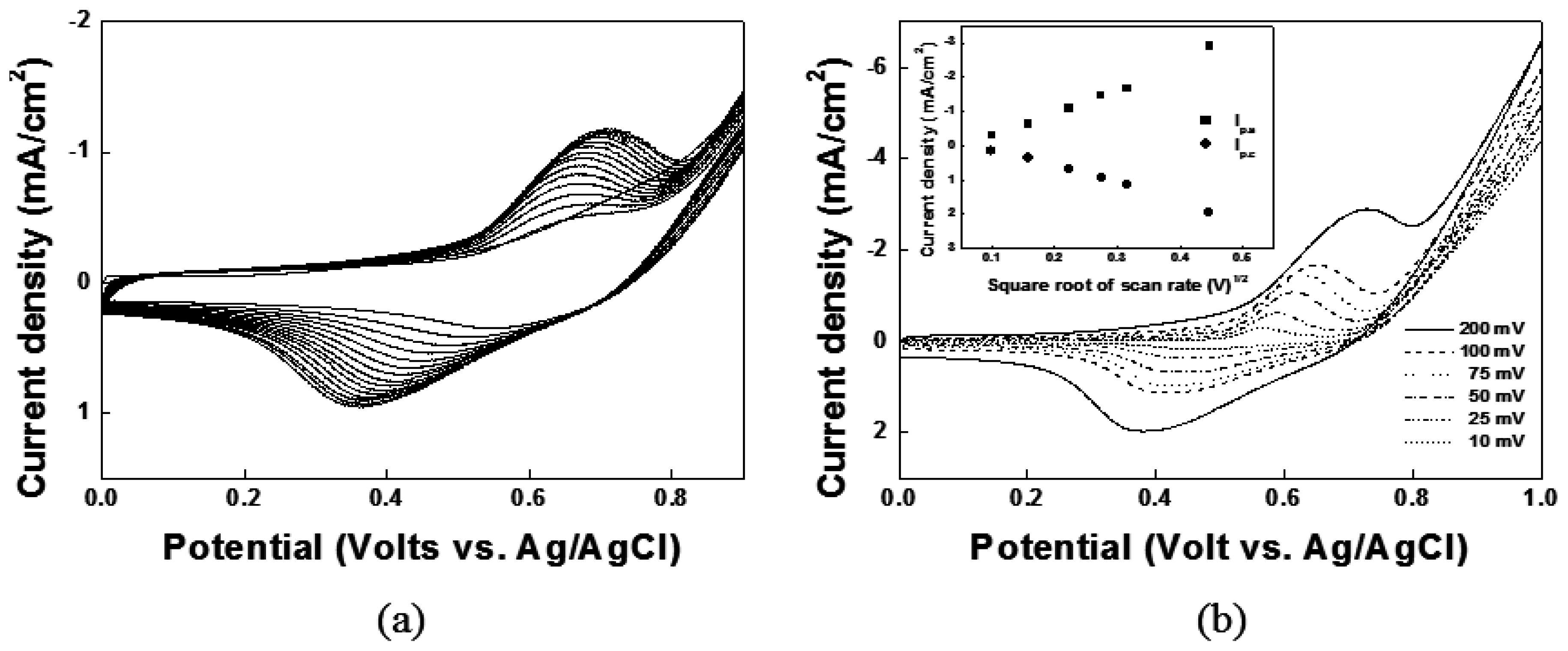
3.1.3. Surface Characteristics of the DSPNCE
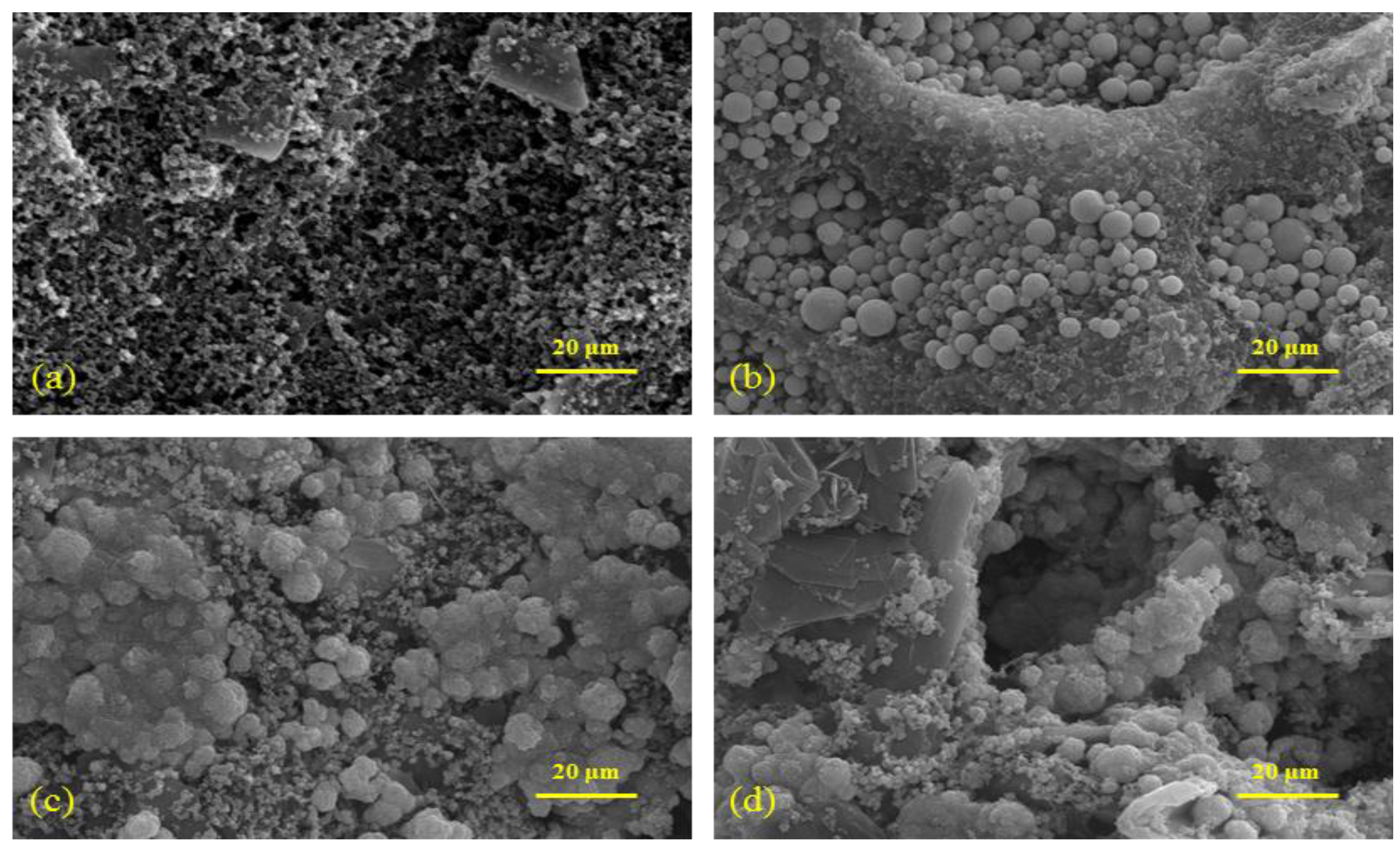
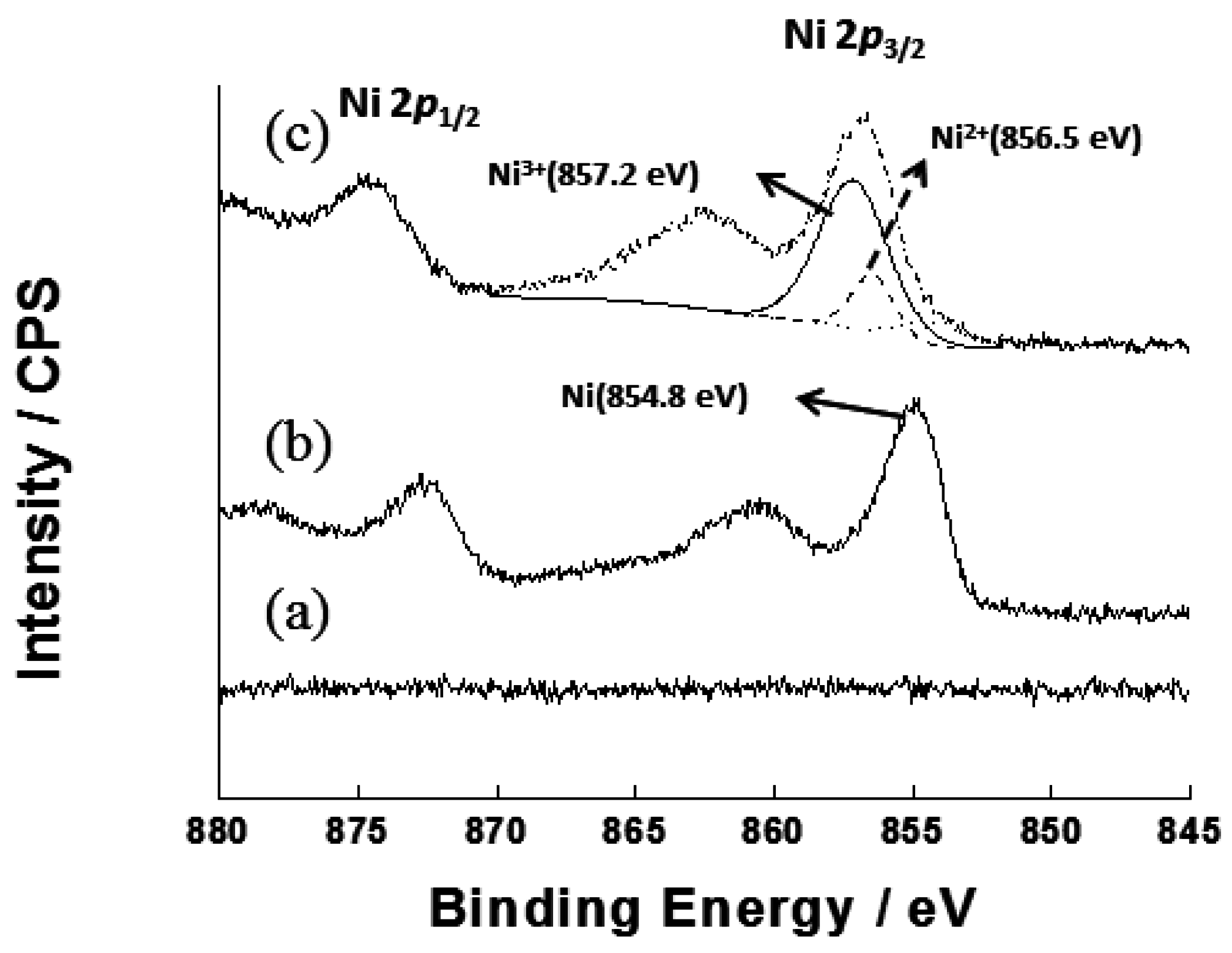
3.2. Electrochemical Measurements for Detecting Glucose
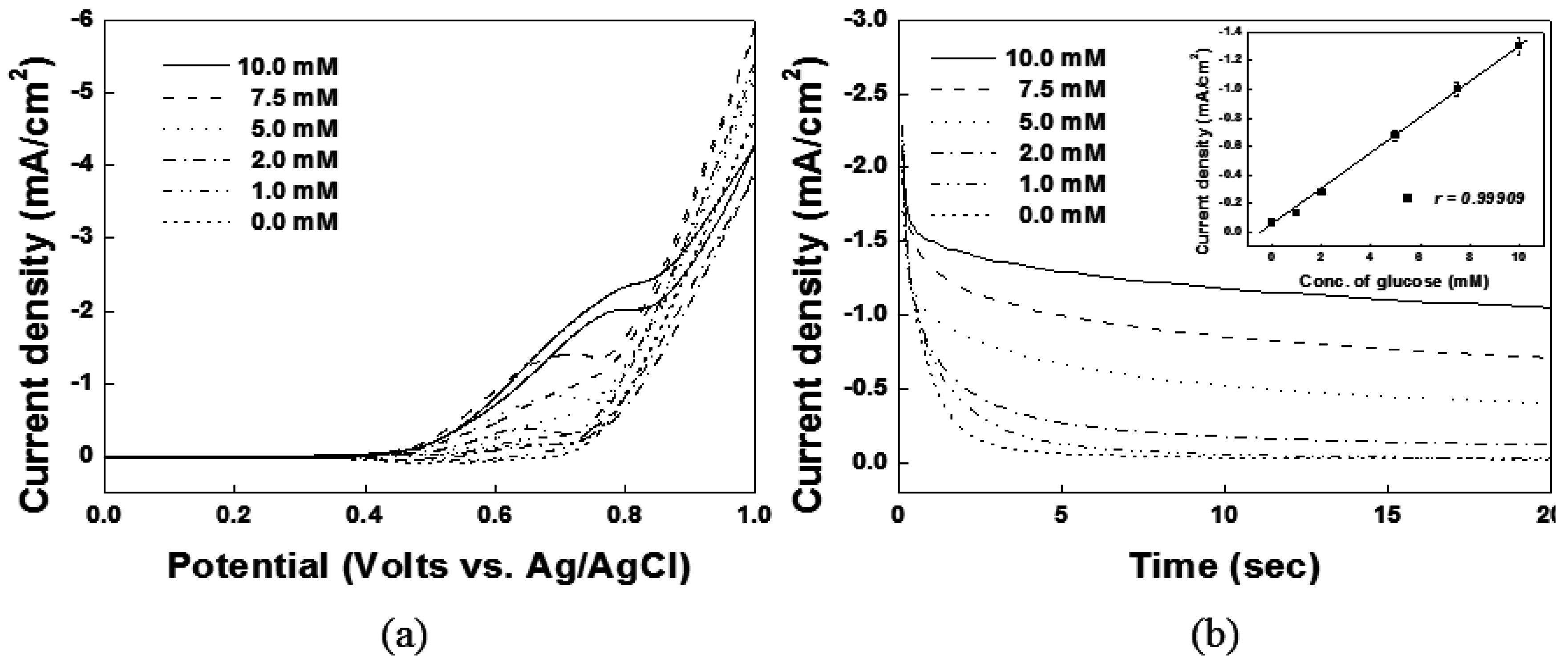
| Electrode Matrix | Sensitivity (mA/cm2) | Linear Range (mM) | Applied Voltage (V) | Ref. |
|---|---|---|---|---|
| Ni(OH)2-CNT-PVDF | 0.044399 | 0.25–39.26 | 0.55 | [31] |
| Roselike a-Ni(OH)2 | 0.4188 | 0.00087–10.53 | 0.4 | [32] |
| NiO-HMSs | 2.39 | 0.00167–6.087 | 0.5 | [33] |
| Ni(OH)2@oPPyNW | 1.049 | 0.001–3.86 | 0.54 | [34] |
| Ni(OH)2/ERGO-MWNT | 2.042 | 0.01–1.5 | 0.54 | [35] |
| Ni paste with carbon | 1.3 | 1.0–10 | 0.65 | This paper |
3.3. Interference Studies of the DSPNCE
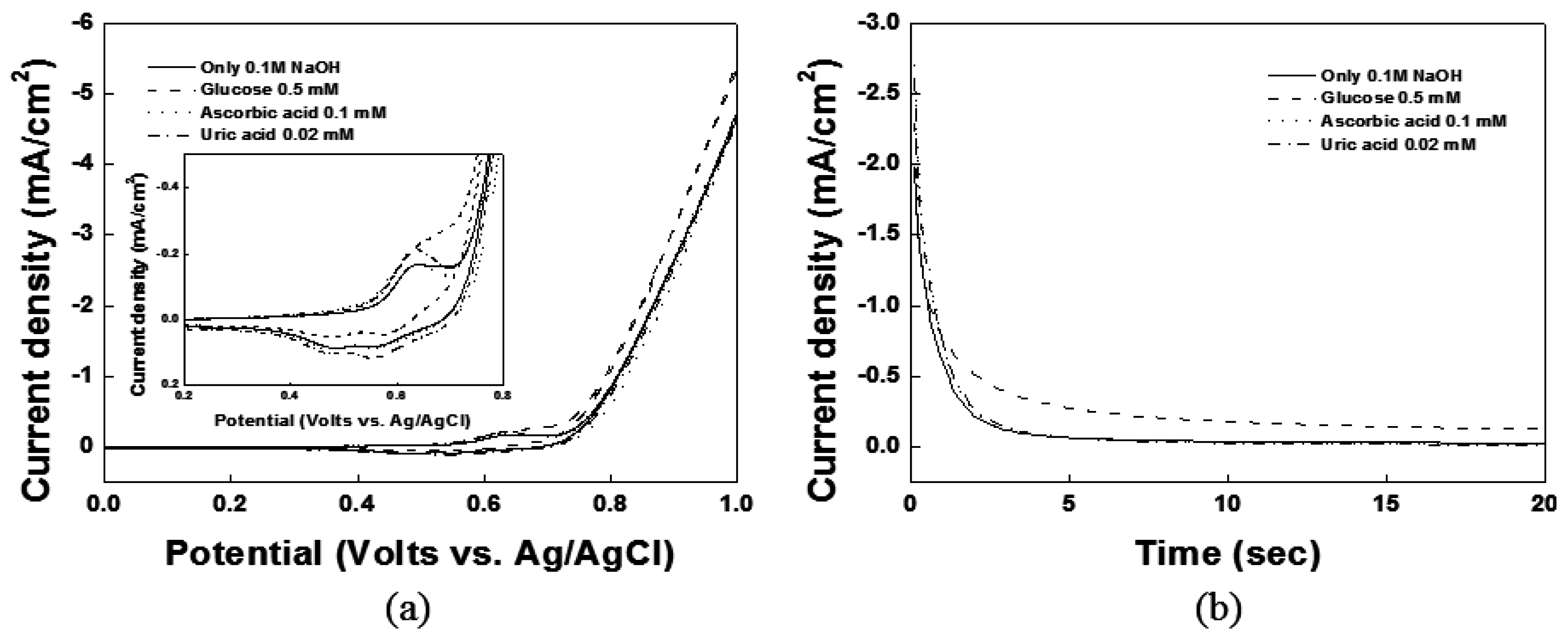
| Serum Sample | Commercial Glucose Sensor (mM) | Added Glucose (mM) | Our Sensor Method (mM) | RSD (%) |
|---|---|---|---|---|
| 1 | 5.38 | |||
| 1.00 | 6.42 | 2.98 | ||
| 2.00 | 7.48 | 3.51 |
4. Conclusions and Outlook
Supplementary Materials
Acknowledgments
Author Contributions
Conflicts of Interest
References
- Food and Agriculture Organization of the United Nations (FAO). Available online: ftp://ftp.fao.org/docrep/fao/006/y5022e/y5022e00.pdf (accessed on 3 November 2015).
- Duara, R.; Grady, C.; Haxby, J.; Ingvar, D.; Sokoloff, L.; Margolin, R.A.; Manning, R.G.; Cutler, N.R.; Rapoport, S.I. Human brain glucose utilization and cognitive function in relation to age. Ann. Neurol. 1984, 16, 702–713. [Google Scholar] [CrossRef]
- Vashist, S.K. Continuous glucose monitoring systems: A review. Diagnostics 2013, 3, 385–412. [Google Scholar] [CrossRef]
- Cox, D.J.; Kovatchev, B.P.; Julian, D.M.; Gonder-Frederick, L.A.; Polonsky, W.H.; Schlundt, D.G.; Clarke, W.L. Frequency of severe hypoglycemia in insulin-dependent diabetes mellitus can be predicted from self-monitoring blood glucose data. J. Clin. Endocrinol. Metab. 1994, 79, 1659–1662. [Google Scholar] [PubMed]
- Van de Ven, K.C.C.; de Galan, B.E.; van der Graaf, M.; Shestov, A.A.; Henry, P.G.; Tack, C.J.J.; Heerschap, A. Effect of acute hypoglycemia on human cerebral glucose metabolism measured by 13C magnetic resonance spectroscopy. Diabetes 2011, 60, 1467–1473. [Google Scholar] [CrossRef] [PubMed]
- Anderson, A.W.; Heptulla, R.A.; Driesen, N.; Flanagan, D.; Goldberg, P.A.; Jones, T.W.; Rife, F.; Sarofin, H.; Tamborlane, W.; Sherwin, R.; et al. Effects of hypoglycemia on human brain activation measured with fMRI. Magn. Reson. Imaging 2006, 24, 693–697. [Google Scholar] [CrossRef] [PubMed]
- Wilson, A.M.; Work, T.M.; Bushway, A.A.; Bushway, R.J. HPLC determination of fructose, glucose, and sucrose in potatoes. J. Food Sci. 1981, 46, 300–301. [Google Scholar] [CrossRef]
- Ansari, R.R.; Böckle, S.; Rovati, L. New optical scheme for a polarimetric-based glucose sensor. J. Biomed. Opt. 2004, 9, 103–115. [Google Scholar] [CrossRef] [PubMed]
- Shafer-Peltier, K.E.; Haynes, C.L.; Glucksberg, M.R.; van Duyne, R.P. Toward a glucose biosensor based on surface-enhanced Raman scattering. J. Am. Chem. Soc. 2003, 125, 588–593. [Google Scholar] [CrossRef] [PubMed]
- Christison, G.B.; MacKenzie, H.A. Laser photoacoustic determination of physiological glucose concentrations in human whole blood. Med. Biol. Eng. Comput. 1993, 31, 284–290. [Google Scholar] [CrossRef] [PubMed]
- Jeon, K.J.; Hwang, I.D.; Hahn, S.J.; Yoon, G.W. Comparison between transmittance and reflectance measurements in glucose determination using near infrared spectroscopy. J. Biomed. Opt. 2006, 11, 014022. [Google Scholar] [CrossRef] [PubMed]
- Larin, K.V.; Eledrisi, M.S.; Motamedi, M.; Esenaliev, R.O. Noninvasive blood glucose monitoring with optical coherence tomography a pilot study in human subjects. Diabetes Care 2002, 25, 2263–2267. [Google Scholar] [CrossRef] [PubMed]
- Wang, J. Electrochemical glucose biosensors. Chem. Rev. 2008, 108, 814–825. [Google Scholar] [CrossRef] [PubMed]
- Yoo, E.H.; Lee, S.Y. Glucose biosensors: An overview of use in clinical practice. Sensors 2010, 10, 4558–4576. [Google Scholar] [CrossRef] [PubMed]
- Clark, L.C.; Lyons, C. Electrode systems for continuous monitoring in cardiovascular surgery. Ann. N. Y. Acad. Sci. 1962, 102, 29–45. [Google Scholar] [CrossRef] [PubMed]
- Toghill, K.E.; Compton, R.G. Electrochemical non-enzymatic glucose sensors: A perspective and an evaluation. Int. J. Electrochem. Sci. 2010, 5, 1246–1301. [Google Scholar]
- Qiao, N.; Zheng, J. Nonenzymatic glucose sensor based on glassy carbon electrode modified with a nanocomposite composed of nickel hydroxide and graphene. Microchim. Acta 2012, 177, 103–109. [Google Scholar] [CrossRef]
- Zhuang, Z.; Su, X.; Yuan, H.; Sun, Q.; Xiao, D.; Choi, M.M.F. An improved sensitivity non-enzymatic glucose sensor based on a CuO nanowire modified Cu electrode. Analyst 2008, 133, 126–132. [Google Scholar] [CrossRef] [PubMed]
- Cao, Z.; Zou, Y.; Xiang, C.; Sun, L.X.; Xu, F. Amperometric glucose biosensor based on ultrafine platinum nanoparticles. Anal. Lett. 2007, 40, 2116–2127. [Google Scholar] [CrossRef]
- Ma, Y.; Di, J.; Yan, X.; Zhao, M.; Lu, Z.; Tu, Y. Direct electrodeposition of gold nanoparticles on indium tin oxide surface and its application. Biosens. Bioelectron. 2009, 24, 1480–1483. [Google Scholar] [CrossRef] [PubMed]
- Wang, J.; Thomas, D.F.; Chen, A. Nonenzymatic electrochemical glucose sensor based on nanoporous PtPb networks. Anal. Chem. 2008, 80, 997–1004. [Google Scholar] [CrossRef] [PubMed]
- Wang, J.; Sun, X.; Cai, X.; Lei, Y.; Song, L.; Xie, S. Nonenzymatic glucose sensor using freestanding single-wall carbon nanotube films. Electrochem. Solid State Lett. 2007, 10, J58–J60. [Google Scholar] [CrossRef]
- Safavi, A.; Maleki, N.; Farjami, E. Fabrication of a glucose sensor based on a novel nanocomposite electrode. Biosens. Bioelectron. 2009, 24, 1655–1660. [Google Scholar] [CrossRef] [PubMed]
- Mu, Y.; Jia, D.; He, Y.; Miao, Y.; Wu, H.L. Nano nickel oxide modified non-enzymatic glucose sensors with enhanced sensitivity through an electrochemical process strategy at high potential. Biosens. Bioelectron. 2011, 26, 2948–2952. [Google Scholar] [CrossRef] [PubMed]
- Toghill, K.E.; Xiao, L.; Phillips, M.A.; Compton, R.G. The non-enzymatic determination of glucose using an electrolytically fabricated nickel microparticle modified boron-doped diamond electrode or nickel foil electrode. Sens. Actuators B Chem. 2010, 147, 642–652. [Google Scholar] [CrossRef]
- Wang, L.; Tang, Y.; Wang, L.; Zhu, H.; Meng, X.; Chen, Y.; Sun, Y.; Yang, X.J.; Wan, P. Fast conversion of redox couple on Ni(OH)2/C nanocomposite electrode for high-performance nonenzymatic glucose sensor. J. Solid State Electrochem. 2015, 19, 851–860. [Google Scholar] [CrossRef]
- Snow, C.W.; Wallace, D.R.; Daniell, A.E. The carbon black-oxygen reaction: Oxidation promotors. Carbon 1968, 6, 224. [Google Scholar] [CrossRef]
- Tian, H.; Jia, M.; Zhang, M.; Hu, J. Nonenzymatic glucose sensor based on nickel ion implanted-modified indium tin oxide electrode. Electrochim. Acta 2013, 96, 285–290. [Google Scholar] [CrossRef]
- Nicholson, R.S.; Shain, I. Theory of stationary electrode polarography. Single scan and cyclic methods applied to reversible, irreversible, and kinetic systems. Anal. Chem. 1964, 36, 706–723. [Google Scholar] [CrossRef]
- Wang, G.; Ling, Y.; Lu, X.; Zhai, T.; Qian, F.; Tong, Y.; Li, Y. A mechanistic study into the catalytic effect of Ni(OH)2 on hematite for photoelectrochemical water oxidation. Nanoscale 2013, 5, 4129–4133. [Google Scholar] [CrossRef] [PubMed]
- Xing, Y.; Gao, G.; Zhu, G.; Gao, J.; Ge, Z.; Yang, H. A nonenzymatic electrochemical glucose sensor based on Ni(OH)2-CNT-PVDF composite and its application in measuring serum glucose. J. Electrochem. Soc. 2014, 5, B106–B110. [Google Scholar] [CrossRef]
- Lu, P.; Lei, Y.; Lu, S.; Wang, Q.; Liu, Q. Three-dimensional roselike α-Ni(OH)2 assembled from nanosheet building blocks for non-enzymatic glucose detection. Anal. Chim. Acta 2015, 880, 42–51. [Google Scholar] [CrossRef] [PubMed]
- Ci, S.; Huang, T.; Wen, Z.; Cui, S.; Mao, S.; Steeber, D.A.; Chen, J. Nickel oxide hollow microsphere for non-enzyme glucose detection. Biosens. Bioelectron. 2014, 54, 251–257. [Google Scholar] [CrossRef] [PubMed]
- Yang, J.; Cho, M.S.; Pang, C.H.; Lee, Y.K. Highly sensitive non-enzymatic glucose sensor based on over-oxidized polypyrrole nanowires modified with Ni(OH)2 nanoflakes. Sens. Actuators B Chem. 2015, 211, 93–101. [Google Scholar] [CrossRef]
- Gao, W.; Tjiu, W.W.; Wei, J.; Liu, T. Highly sensitive nonenzymatic glucose and H2O2 sensor based on Ni(OH)2/electroreduced graphene oxide—Multiwalled carbon nanotube film modified glass carbon electrode. Talanta 2014, 120, 484–490. [Google Scholar] [CrossRef] [PubMed]
© 2015 by the authors; licensee MDPI, Basel, Switzerland. This article is an open access article distributed under the terms and conditions of the Creative Commons by Attribution (CC-BY) license (http://creativecommons.org/licenses/by/4.0/).
Share and Cite
Jeon, W.-Y.; Choi, Y.-B.; Kim, H.-H. Disposable Non-Enzymatic Glucose Sensors Using Screen-Printed Nickel/Carbon Composites on Indium Tin Oxide Electrodes. Sensors 2015, 15, 31083-31091. https://doi.org/10.3390/s151229846
Jeon W-Y, Choi Y-B, Kim H-H. Disposable Non-Enzymatic Glucose Sensors Using Screen-Printed Nickel/Carbon Composites on Indium Tin Oxide Electrodes. Sensors. 2015; 15(12):31083-31091. https://doi.org/10.3390/s151229846
Chicago/Turabian StyleJeon, Won-Yong, Young-Bong Choi, and Hyug-Han Kim. 2015. "Disposable Non-Enzymatic Glucose Sensors Using Screen-Printed Nickel/Carbon Composites on Indium Tin Oxide Electrodes" Sensors 15, no. 12: 31083-31091. https://doi.org/10.3390/s151229846





